Pros
Cons
Introduction
Design
Front
{{section_header}}{{section.name}}{{/section_header}}

Back
{{section_header}}{{section.name}}{{/section_header}}

Left
{{section_header}}{{section.name}}{{/section_header}}
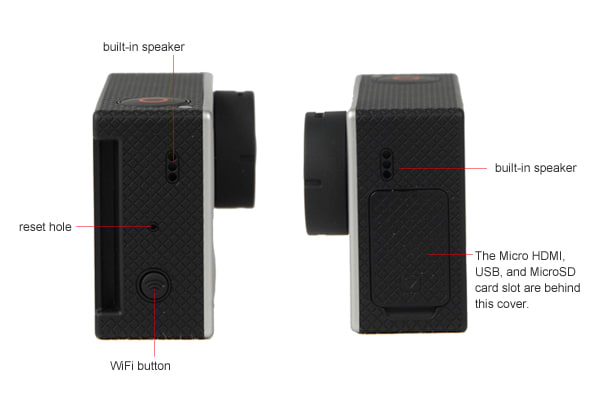
Right
{{section_header}}{{section.name}}{{/section_header}}
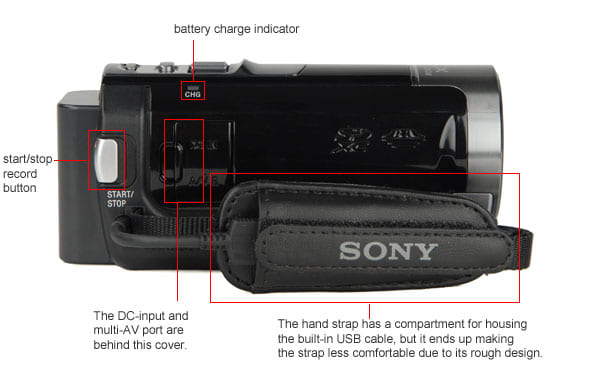
Top
{{section_header}}{{section.name}}{{/section_header}}

Bottom
{{section_header}}{{section.name}}{{/section_header}}

Size & Weight Comparison
{{section_header}}{{section.name}}{{/section_header}}
In the Box
{{section_header}}{{section.name}}{{/section_header}}

Included in the box with the Sony 3D Bloggie are the camera and:
- USB extender
- Wrist strap
- Quick start instruction guide
- Warranty information
Performance
Color
{{section_header}}{{section.name}}{{/section_header}}
The 3D Bloggie managed a color error of 10.81 in our bright light testing, more than twice as poor as it performed in low light and roughly three times worse than the Bloggie Touch. Its images were very vibrant, with a saturation level of 133%. Your videos will really pop, but such a heavy vibrancy will also play havoc on skin tones and other colors you may want to record more accurately. The real culprit is the camera's white balance, which is very hit-or-miss, but is handled entirely automatically by the camera. More on how we test color.
There are no color modes to speak of on the 3D Bloggie, with no real manual control over picture fidelity, saturation, contrast, or sharpness. All shooting, exposure, and color settings are handled entirely automatically by the camera.
The Kodak Zx5 actually performed worse than the 3D Bloggie here, with a particularly poor color error of 16.54 owed to its incredibly high 166% saturation level. That certainly makes the 3D Bloggie look better, though its predecessor—the Bloggie Touch—had a far better color error of just 3.69, favoring muted colors with a saturation level of 80% of the ideal. The Panasonic SDT750 costs signficantly more, but performed significantly better, with a color error of just 3.04 and a near perfect saturation level.
Below you can see some example crops to get an idea of the discrepancy in color performance for each camera in the comparison group.
The Panasonic SDT750 obviously scored the best in this group, but it should perform that well as it's essentially a prosumer camcorder. Among the cameras in this class, the Bloggie Touch did surprisingly well, though it did suffer from some undersaturation. The 3D Bloggie was only saved by the Kodak Zx5's poor performance, but neither camera's performance could be described in glowing terms.
{{comparison_bars title="Color Score Comparison", attribute="Color Score", xLabel="Color Score"}}
Low Light Color
{{section_header}}{{section.name}}{{/section_header}}
The 3D Bloggie actually had more accurate colors in low light testing than in bright light, with a color error of 5.04 under dim lighting conditions. Video was substantially undersaturated, however, registering at just 75.42% of the ideal. As a result the images looked very muted, and there's no manual color control to offset this. More on how we test low light color.
The low light color results for the 3D Bloggie were right in line with what the rest of our comparison group managed. The Panasonic SDT750 managed a color error of just 4.28 and more accurate saturation, but not by as large a margin as you might think. The Bloggie Touch had slightly worse results, with just a hair less color accuracy and even less saturation. The Kodak Zx5 managed the most accurate saturation level of any camera in our comparison group, but with the greatest color error of the lot.
Noise
{{section_header}}{{section.name}}{{/section_header}}
The 3D Bloggie managed to reign in noise pretty effectively in bright light testing, registering just 0.55% noise. This was only slightly worse than the Bloggie Touch, but worse than the Panasonic SDT750. The Kodak Zx5 had the most noise apparent in its bright light videos, with 0.66% noise present. More on how we test noise.
The Bloggie Touch actually produced some nice noise results, as you can see below, with images that look sharp without much haloing. The Panasonic SDT750 had the least amount of noise, but there appears to be some heavy oversharpening applied, with some haloing visible in the sharpness trumpet. The Kodak Zx5 and 3D Bloggie both look poor by comparison, with the Zx5 struggling to render much contrast.
{{comparison_bars title="Noise Score Comparison", attribute="Noise Score", xLabel="Noise Score"}}
Low Light Sensitivity
{{section_header}}{{section.name}}{{/section_header}}
The 3D Bloggie was quite sensitive in low light, requiring just eight lux to produce a 50 IRE image on a waveform monitor. We also tested the camera's 3D recording and found no difference in the amount of light required. These results aren't a huge surprise, as the 3D Bloggie has a fast (f/2.8) lens, and automatically controls all exposure settings. More on how we test low light sensitivity.
The 3D Bloggie showed a solid improvement over the Bloggie Touch (TS10/TS20) in our low light sensitivity testing, which needed 11 lux of light to reach 50 IRE. It's also better than what the Panasonic HDC-SDT750 managed, as that camera required 12 lux of light, though the results were substantially better. When shooting 3D video, the Bloggie again only needed the same eight lux. The Panasonic SDT750, by comparison, needed 55 lux to record 3D video, though at a much higher quality.
{{comparison_bars title="Low Light Sensitivity Comparison", attribute="Low Light Sensitivity Score", xLabel="Low Light Sensitivity Score"}}
Low Light Noise
{{section_header}}{{section.name}}{{/section_header}}
The 3D Bloggie suffered from the most noise of any of the cameras in our comparison group, with over 1% of the total image registering as noise. This isn't a complete surprise, as the camera features a sensor that is smaller (1/4'') than all the other cameras in this group. More on how we test low light noise.
With the Sony 3D Bloggie having the smallest sensor in this group, it's not a big surprise that its noise results were the worst of the lot. The fact that it's been made more sensitive in low light also certainly plays a role. The Bloggie Touch models registered just 0.57% noise in this test, while the Panasonic HDC-SDT750 (0.68%) and the Kodak Zx5 (0.83%) were worse, but still better than the 3D Bloggie.
{{comparison_bars title="Low Light Noise Score Comparison", attribute="Low Light Noise Score", xLabel="Low Light Noise Score"}}
Low Light Color
{{section_header}}{{section.name}}{{/section_header}}
The 3D Bloggie actually had more accurate colors in low light testing than in bright light, with a color error of 5.04 under dim lighting conditions. Video was substantially undersaturated, however, registering at just 75.42% of the ideal. As a result the images looked very muted, and there's no manual color control to offset this. More on how we test low light color.
The low light color results for the 3D Bloggie were right in line with what the rest of our comparison group managed. The Panasonic SDT750 managed a color error of just 4.28 and more accurate saturation, but not by as large a margin as you might think. The Bloggie Touch had slightly worse results, with just a hair less color accuracy and even less saturation. The Kodak Zx5 managed the most accurate saturation level of any camera in our comparison group, but with the greatest color error of the lot.
Motion
{{section_header}}{{section.name}}{{/section_header}}
We found that the 3D Bloggie was just a notch below the Bloggie Touch, in terms of its reproduction of motion. There was a bit more signal interference and ghosting, with some color bleeding on the pinwheel in our example motion rig. This is likely due to the smaller sensor in the 3D Bloggie, which sports a 1/4'' CMOS sensor compared to the Bloggie Touch's 1/2.5'' sensor. In shooting 3D, we found motion was best recorded with the camera kept in a stationary, level position, such as on a tripod. Trailing and ghosting is more pronounced in 3D, but the illusion of depth is obviously increased significantly. More on how we test motion.
Video Sharpness
{{section_header}}{{section.name}}{{/section_header}}
We found the 3D Bloggie was able to render 550 lw/ph of sharpness in horizontal motion and 700 lw/ph vertically. These were slightly different results than we got with the Bloggie Touch, which had greater sharpness horizontally, but less vertically. These are far below the Panasonic SDT750, of course, but they are also a slight drop from the Kodak Zx5, which managed 700 lw/ph in both directions. More on how we test video sharpness.
{{comparison_bars title="Video Sharpness Score Comparison", attribute="Video Sharpness Score", xLabel="Video Sharpness Score"}}
Stabilization
{{section_header}}{{section.name}}{{/section_header}}
The 3D Bloggie makes use of Sony's SteadyShot image stabilization. This system is not optical in nature, so it will affect the shooting settings used by the camera in order to reduce blur due to camera shake. This isn't a great surprise, since most optical stabilization systems involve moving either lens elements or the sensor itself, which would likely make 3D capture nearly impossible to get right. As the 3D Bloggie does not offer the option to turn off image stabilization, however, we are unable to test to see if it actually offers any improvement in sharpness. More on how we test stabilization.
Testing Samples
{{section_header}}{{section.name}}{{/section_header}}
Usability
Ease of Use
{{section_header}}{{section.name}}{{/section_header}}
The 3D Bloggie is very simple to operate, as long as you are not looking to make any fine adjustments to shooting settings. There's also nothing in terms of creative modes that filter the video in any fun or interesting ways, meaning there's little to do other than turn the thing on, point it at something interesting, and hit record.
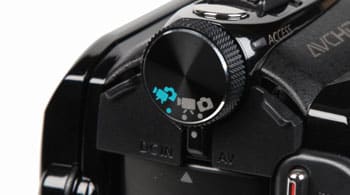
Auto Mode is confusingly called Dual Shot mode
The menu on the 3D Bloggie is very simple to navigate. When shooting, the three buttons just beneath the LCD enter playback, 3D/2D mode, or the menu. The menu screen offers options for setting still resolution, video resolution, and a further setup menu. The setup menu only allows the user to set basic settings such as date/time, flicker reduction, HDMI output rate, and language.
Auto Mode
{{section_header}}{{section.name}}{{/section_header}}
The Sony 3D Bloggie does not feature much in the way of manual modes, as most of its shooting parameters are set automatically by the camera depending on the scene it thinks it is being pointed at. There are no user-selectable scene modes or anything that would emphasize any particular kind of shot over another. The auto mode also handles quick changes in lighting conditions fairly well, smoothly adjusting exposure from daylight to shadow.
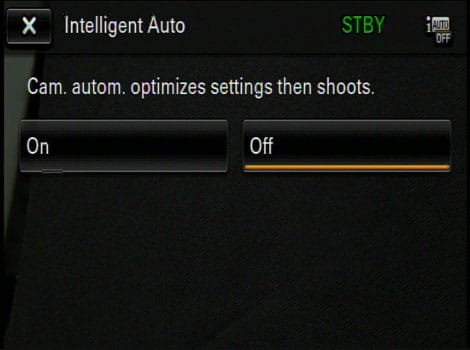
The iAuto mode button is difficult to find, but when you do find it the option for turning on the mode looks like this.
Auto Controls
{{section_header}}{{section.name}}{{/section_header}}
The 3D Bloggie essentially handles everything on its own, with the only real user input being when to start and stop recording. The camera does tend to quickly alter its settings should you move quickly from one lighting condition to another, adjusting exposure and white balance accordingly. The lens does quickly adjust for close focus, though we'd recommend keeping around five or six inches away from the subject, more than the four inches recommended by Sony.
Handling
{{section_header}}{{section.name}}{{/section_header}}
The 3D Bloggie is definitely designed to be shot horizontally, whether taking advantage of the two lenses to shoot 3D video or not. When shooting 2D video, holding the camera vertically like the Flip camcorders results in video that is letterboxed significantly. This is the same quirk we found on the Bloggie Touch and Sony has obviously elected to not remedy it here. It really makes shooting video with one hand a pain, as holding it horizontally makes the record button very difficult to press with the thumb without losing one's grip on the camera.

Once you figure out how to hold the 3D Bloggie, it's clear this is a lightweight shooter that is ready to record just about anywhere at a moment's notice. It's got a nice rubber coating on the front and both long sides, making for an easy grip that also doesn't get scratched easily. The landscape design only becomes a real detraction when you want to employ a tripod, since the mount is located on the "bottom," which, if kept vertical, precludes capture of either 3D video or full-resolution 2D.

The 3D Bloggie, because it makes use of two lenses that are designed to mimic the stereoscopic nature of a person's eyes, must generally be kept level to get a proper 3D effect. While these ultracompact handheld camcorders may have ushered in a new era of cinéma vérité, the 3D Bloggie may want to sit out on the Battle of Algiers (Cloverfield for you young'uns) action. Even when just shooting in 3D, watching the screen overlay both images while moving in any kind of up-and-down motion is enough to make your head hurt.


These dedicated buttons give you quick access to aperture and shutter speed controls.
Portability
{{section_header}}{{section.name}}{{/section_header}}
The 3D Bloggie weighs in at just 4.2oz, certainly lightweight enough to be comfortably on your person all day without being a nuisance. It's small enough to fit in just about any pocket, as well, with dimensions of just 2.25" x 4.375" x 0.686" (W x H x D, depending on how you hold it). Since it comes with its own slide-out USB arm, only has an internal battery, and only has internal memory, there's little that you'll have to remember when you head out of town with the 3D Bloggie—except something with a USB port to charge it and transfer video to.
LCD
{{section_header}}{{section.name}}{{/section_header}}
Sony has elected to not offer any touchscreen control on the 3D Bloggie, instead opting for its 2.4-inch screen with four-way control pad on the bottom. The screen is not particularly detailed, with a resolution of just 230k, and isn't much use for judging exposure. If you're shooting from odd angles, the shooting information display will also re-orient depending on how the camera is held, though the full setup menu only displays in landscape mode. The screen is designed to display images in 3D without the need for glasses, but the effect is more akin to being bludgeoned in the brain with a Magic Eye painting.
Stabilization
{{section_header}}{{section.name}}{{/section_header}}
The 3D Bloggie makes use of Sony's SteadyShot image stabilization. This system is not optical in nature, so it will affect the shooting settings used by the camera in order to reduce blur due to camera shake. This isn't a great surprise, since most optical stabilization systems involve moving either lens elements or the sensor itself, which would likely make 3D capture nearly impossible to get right. As the 3D Bloggie does not offer the option to turn off image stabilization, however, we are unable to test to see if it actually offers any improvement in sharpness. More on how we test stabilization.
Manual Focus
{{section_header}}{{section.name}}{{/section_header}}
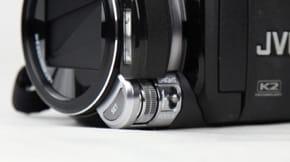
The adjustment dial makes accurate focus adjustments easy.
Manual Exposure
{{section_header}}{{section.name}}{{/section_header}}
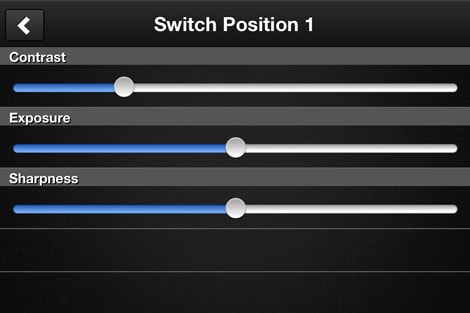
The manual exposure controls are only found on the Contour app, not on the camcorder itself.
Miscellaneous Controls
{{section_header}}{{section.name}}{{/section_header}}
Self-Timer
The 3D Bloggie can make use of a two or ten-second self-timer, which is activated by pressing the corresponding button on the four-way control pad. The timer begins when the video or still record button is pressed, and there's no custom setting to control the number of shots or duration of video recorded.
Auto Controls
{{section_header}}{{section.name}}{{/section_header}}
The 3D Bloggie essentially handles everything on its own, with the only real user input being when to start and stop recording. The camera does tend to quickly alter its settings should you move quickly from one lighting condition to another, adjusting exposure and white balance accordingly. The lens does quickly adjust for close focus, though we'd recommend keeping around five or six inches away from the subject, more than the four inches recommended by Sony.
Audio Controls
{{section_header}}{{section.name}}{{/section_header}}
Audio recording is a fairly bare bones operation with the 3D Bloggie, similar to just about every other ultracompact camcorder. The camera will record audio using its built-in stereo microphone, but there's no fine control for level, wind-cut, or high/low sensitivity.
Editing
{{section_header}}{{section.name}}{{/section_header}}
There is no software disc included with the 3D Bloggie, as the camera instead has everything included on its internal memory. When attached by USB the 3D Bloggie will install version 1.3 of the Bloggie Software (up from 1.0 that we tested on the TS10). It's still fairly pared down, providing only the most basic support for importing media, registering the product, and uploading to various sharing websites and through e-mail, with no real video editing ability to speak of. The software is accessed by attaching the camera through the computer's USB port and following the instructions provided with the camera. The software is compatible with both PC and Mac. For an overview of the software that ships with this and other camcorders, see our article: Video Editing Software For Your Camcorder{{product.brand.name}}-Included-Software.htm.
The Sony 3D Bloggie does not feature any real internal editing of any kind. The only options available once a video has been captured are to delete it, mark it for protection, or mark it to be shared later. Once a video or image has been marked for sharing, it will be uploaded when the camera is attached to a computer once its sharing software is installed.
Features
Compression
{{section_header}}{{section.name}}{{/section_header}}
There are several compression options on the 3D Bloggie. It shoots 1080/30p (or 720/60p) MP4 video and audio using the H.264 and AAC codecs, respectively. The camera also shoots still images, for which it just uses JPG compression, with a maximum resolution of five megapixels. Read more about the advantages and disadvantages of various high definition compression types.
Media
{{section_header}}{{section.name}}{{/section_header}}
The 3D Bloggie comes with 8GB of internal memory, which is enough for approximately 80 minutes of either full 1080/30p 2D video or 3D video. There are no options to extend the internal memory with any sort of a memory card and the memory is not removable in any way. Read more about the advantages and disadvantages of various media types.

Slow Motion Modes
Still Features
{{section_header}}{{section.name}}{{/section_header}}
The 3D Bloggie offers a few still image shooting options, though again there is no real manual control. The Bloggie can shoot 5-megapixel still images in a 4:3 aspect ratio, or 3.1-megapixel images in 16:9. The images can be recorded in either 2D or 3D, with the 3D stills offering greater depth when viewed on a 3D-capable television. Stills can be recorded at nearly any time, as there's a dedicated still shutter release next to the power button on the side of the camera.
Lens & Imaging System
{{section_header}}{{section.name}}{{/section_header}}

The 3D Bloggie has a small drop in sensor size from the Bloggie Touch, with a 1/4'' Exmor CMOS sensor. That drop in size did come at a small penalty to color error and noise performance, though low light sensitivity improved. The camera also features two f/2.8 lenses that produce the visual disparity of its stereoscopic 3D image and an angle of view of 44 degrees. Whether shooting in 3D or 2D, the angle of view is the same. The twin lens design also does not inhibit the amount of light entering the camera, as low light sensitivity are the same regardless of which mode the user is shooting in.
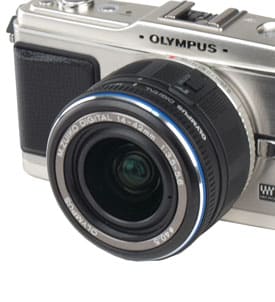
LCD
{{section_header}}{{section.name}}{{/section_header}}
Sony has elected to not offer any touchscreen control on the 3D Bloggie, instead opting for its 2.4-inch screen with four-way control pad on the bottom. The screen is not particularly detailed, with a resolution of just 230k, and isn't much use for judging exposure. If you're shooting from odd angles, the shooting information display will also re-orient depending on how the camera is held, though the full setup menu only displays in landscape mode. The screen is designed to display images in 3D without the need for glasses, but the effect is more akin to being bludgeoned in the brain with a Magic Eye painting.
Connectivity
{{section_header}}{{section.name}}{{/section_header}}
The 3D Bloggie has a built-in USB arm for connecting it to a computer and charging the internal battery. The camera comes with a small A/B USB extension cable, as well, to aid charging on desktops or wall chargers.
The 3D Bloggie also comes with a mini-HDMI output port. The camera can output directly to a 3D-capable television with a compatible HDMI cable. Control is not perfect, and the 3D Bloggie only outputs while in playback mode, but it's by far the simplest way to view your 3D videos on a television.
Battery
{{section_header}}{{section.name}}{{/section_header}}
Frustratingly, the 3D Bloggie takes after its predecessors, in terms of utilizing an internal battery rather than a user-replaceable lithium-ion battery. This is surely easier for Sony to design around, but it's a hindrance to users who might actually use their product enough that their battery life will be worn down over time.

Media
{{section_header}}{{section.name}}{{/section_header}}
The 3D Bloggie comes with 8GB of internal memory, which is enough for approximately 80 minutes of either full 1080/30p 2D video or 3D video. There are no options to extend the internal memory with any sort of a memory card and the memory is not removable in any way. Read more about the advantages and disadvantages of various media types.

3D Lens
{{section_header}}{{section.name}}{{/section_header}}
The dual lenses on the 3D Bloggie provide no optical zoom of any kind, with a fixed aperture of f/2.8. The lenses are oriented in a way that the camera must be held horizontally to properly record 3D. Unlike some of the other 3D cameras we've tested, we found the lenses provided a 44 degree angle of view in both 3D and 2D shooting.
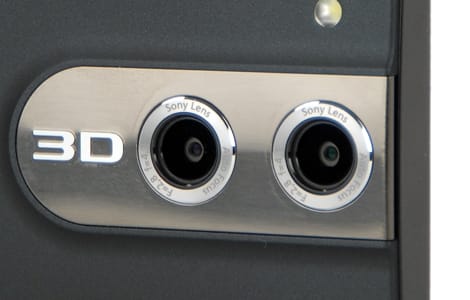
The second built-in lens is what lets you record video in 3D—without any tricky calibration.
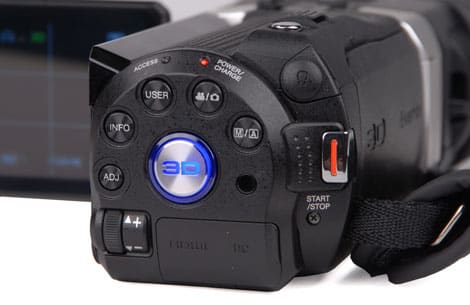
You can adjust a variety of controls—including zoom and focus—in 3D record mode.
3D Controls
{{section_header}}{{section.name}}{{/section_header}}
There’s, again, not much in the way of actual control on the 3D Bloggie, and this holds true when recording 3D video. Most of the shooting settings are out of the user’s hands, though the camera does a decent job of recording video with proper exposure. Whenever the user selects 3D mode, the camera will warn the user that it cannot record 3D unless held in landscape mode, and the screen automatically begins to display the recorded images as 3D. Check out the video below to see how the Bloggie’s 3D video looks when uploaded to YouTube. Keep in mind, this video has been converted (by YouTube) into a red/cyan 3D clip. This means you need those funky 3D glasses (with one red eye and one cyan eye) in order to view the video in 3D.
3D Playback
{{section_header}}{{section.name}}{{/section_header}}
It is possible to view the 3D video shot on the 3D Bloggie on the rear 2.4'' screen, though this is accomplished with an annoying effect similar to holographic baseball cards, only more annoying. As this aspect can't be turned off in the menu, proper composition when shooting 3D becomes a bit of a chore. When playing back to a television, however, the screen displays in 2D and marks which files are 2D and which are 3D.

The 3D effect is also not particularly pronounced on such a small screen. When viewed on a large 3D-capable television, the 3D Bloggie really earns its keep, as it reproduces depth very well. It's able to handle changes in parallax quickly and smoothly. We'd go so far as to say that, with the price taken into consideration, this is the first camera worth buying exclusively for the 3D capability.
Still Features
{{section_header}}{{section.name}}{{/section_header}}
The 3D Bloggie offers a few still image shooting options, though again there is no real manual control. The Bloggie can shoot 5-megapixel still images in a 4:3 aspect ratio, or 3.1-megapixel images in 16:9. The images can be recorded in either 2D or 3D, with the 3D stills offering greater depth when viewed on a 3D-capable television. Stills can be recorded at nearly any time, as there's a dedicated still shutter release next to the power button on the side of the camera.
Other Features
{{section_header}}{{section.name}}{{/section_header}}
Video Light
The 3D Bloggie has a small LED light on the front of the camera that is activated by pressing the corresponding button on the four-way directional pad. The light is fairly harsh, but surprisingly powerful for such a small camera. It won't do much in still recording, but it should brighten up scenes in an emergency.
NTSC/PAL Output
You can switch the Sony 3D Bloggie over to PAL output if you want to connect the camcorder to a television that runs on the PAL system. This isn’t a feature most people will ever use, but it makes it possible for Sony to develop one version of the Bloggie for both the US and European markets.
Panasonic HDC-SDT750 Comparison
The MHS-FS3 is Sony’s first Bloggie camcorder that can record 3D, so you won’t find that feature on last year’s Bloggie Touch MHS-TS10. What the Bloggie Touch does have, however, is a touchscreen LCD—something that is not present on the Bloggie 3D. The MHS-TS10 also has a slightly slimmer body design than the MHS-FS3, and it has a metal finish that gives it a different feel in your hand. Sony also redesigned the built-in USB arm element for the Bloggie 3D, adding a release switch instead of the push-release system found on the Bloggie Touch.
The video above shows the Bloggie 3D and last year's Bloggie Touch in a side-by-side shooting comparison. As a 2D camcorder, the Bloggie Touch MHS-TS10 did better than the MHS-FS3 in our testing. It handled white balance better, which resulted in stronger color accuracy in both bright and low light, and its motion videos were a tad superior. When we shot with the two camcorders side-by-side, we couldn’t really see a difference in terms of sharpness (and the two models scored nearly the same in our sharpness tests).
The Bloggie Touch MHS-TS10 has a larger image sensor and a larger wide angle than its 3D cousin, and we felt it was the superior camcorder for recording 2D video. Its colors looked better and the wider lens made framing easier. What we’d love to see, and perhaps will see in the future, is a 3D Bloggie with the same 2D performance as the MHS-TS10.
Kodak PlaySport Zx5 Comparison
The Panasonic HDC-SDT750 was the first consumer camcorder that could record 3D videos. Since its launch, a number of 3D camcorders have been released, and all of them—the Bloggie 3D MHS-FS3 included—have shown us better 3D performance than the HDC-SDT750. Of course, the Panasonic SDT750 is a wildly different camcorder than the Bloggie 3D, so the only reasonable comparison to make between the two is in terms of their 3D recording quality.
The SDT750 handles 3D recording in an unusual way. The camcorder is not ready to shoot 3D out of the box, but you must instead attach and calibrate a 3D conversion lens before 3D recording may commence. Its a sticky process that is both annoying and time consuming depending how familiar you are with the camcorder.
The Bloggie 3D, on the other hand, is the simplest 3D camcorder we've seen so far. With the press of a single button you can start recording 3D videos immediately, and, to top it all off, the Bloggie's 3D videos look better than what you get with the Panasonic.
To produce the 3D effect, both camcorders simultaneously record side-by-side images as one Full HD image and then overlap these images to create one 3D video. This is a different process than the "Double Full HD" setting that JVC touts on its GS-TD1 and that Sony offers on its HDR-TD10 (both of which cost in the vicinity of $1500).
If you want to play around with 3D recording, and you don't have the desire or need for a high-end camcorder, the Bloggie 3D MHS-FS3 is the far better choice. The Panasonic is an excellent camcorder, but its 3D capabilities are limited and make it a bulkier, pricer model. Purchasing the Bloggie 3D won't break the bank, and its 3D videos looked surprisingly good. Any time a $250 camcorder can match the performance of a $1000 camcorder, we are at least somewhat in awe. And that's what the Bloggie 3D MHS-FS3 did—at least in terms of 3D performance.
COMP 3
The Kodak PlaySport Zx5 can't record 3D video, but it has a different trick up its sleeve: a waterproof design. We think the waterproof design of the Zx5 is the more useful feature, while the 3D capability of the MHS-FS3 is more unique (at least for now).
The PlaySport Zx5 had many problems in our testing, particularly a focus issue that made it impossible for the camcorder to produce an sharp image on the left side of the frame. Still, its design and interface are among the best we've seen from an ultracompact camcorder, which is why we praise it, and the previous Kodak PlaySport Zx3, so highly. Overall, the PlaySport and the Bloggie 3D scored very similarly in our performance testing, although both camcorders had trouble with their auto white balance systems.
These two models are similar in size and performance, so its really up to the special features to set them apart. And its these special features (waterproof vs. 3D) that will make the decision for you as to which of these camcorders to buy. If you're the adventuresome type who wants a camcorder that can take an accidental bath or a beating, the Kodak PlaySport Zx5 is the best camcorder for you. If you're a new owner of a 3D HDTV and want to create some of your own 3-dimensional content, then the Bloggie 3D MHS-FS3 is a perfect fit.
Conclusion
The Sony 3D Bloggie, otherwise known as the MHS-FS3, shows just how dedicated Sony is to making 3D video a part of your everyday life. The camera features two lenses to record 3D, creating a visual disparity that will display on most 3D-capable televisions directly from the camera. Even the camera's 2.4-inch LCD is designed to display back 3D video without the need for glasses.
It's a show of just how quickly the technology has advanced—and how far it still has to go. Make no mistake, we think the Sony 3D Bloggie is the first 3D camcorder worth buying exclusively for its 3D capabilities. If you want a simple to use, out-of-the-box 3D recording experience, then this is the camera for you.
There are a few catches: it's a compact camera, with no real manual control and little to no editing support whatsoever. The camera also suffers from an occasional white balance error that, without the ability to manually override it, can drastically throw off colors under certain lighting conditions. We found that its 2D performance took a step back from what Sony managed in the similarly sized Bloggie Touch, as well.
Still, if you're a fan of 3D video, have already shelled out for the 3D-capable television, and don't want to spend another $1400 on a complicated prosumer camcorder just to record some quick home movies in 3D, then the Bloggie is your answer.
It can't match prosumer options for control, sharpness, or 2D recording prowess, but it rendered depth as well as any other camera we have tested. Even in constantly changing conditions, we found it to record some of the most pleasing 3D video yet. We'd like to see the next 3D Bloggie get back some of the performance it lost from the Bloggie Touch, but the MHS-FS3 is a step 3D enthusiasts will want to pick up.
Photo Gallery
{{photo_gallery "Front Photo", "Left Photo", "Left Open Photo", "Back Photo", "Right Photo", "Top Photo", "Bottom Photo", "Lens Photo", "Lens Photo 2", "3D Lens Photo", "Media Photo", "Easy Mode Photo", "Manual Controls Photo", "Zoom Photo", "Zoom Photo 2", "Ease of Use Photo", "Battery Photo", "LCD Photo 1", "LCD Photo 2", "EVF Photo 1", "EVF Photo 2", "Mic Photo", "Mic Photo 2", "Ports Photo 1", "Ports Photo 2", "Ports Photo 3", "Ports Photo 4", "Ports Photo 5", "Ports Photo 6", "Handling Photo 1", "Handling Photo 2", "Handling Photo 3", "Handling Photo 4", "Box Photo"}}
Meet the tester
TJ is the former Director of Content Development at Reviewed. He is a Massachusetts native and has covered electronics, cameras, TVs, smartphones, parenting, and more for Reviewed. He is from the self-styled "Cranberry Capitol of the World," which is, in fact, a real thing.
Checking our work.
Our team is here to help you buy the best stuff and love what you own. Our writers, editors, and experts obsess over the products we cover to make sure you're confident and satisfied. Have a different opinion about something we recommend? Email us and we'll compare notes.
Shoot us an email